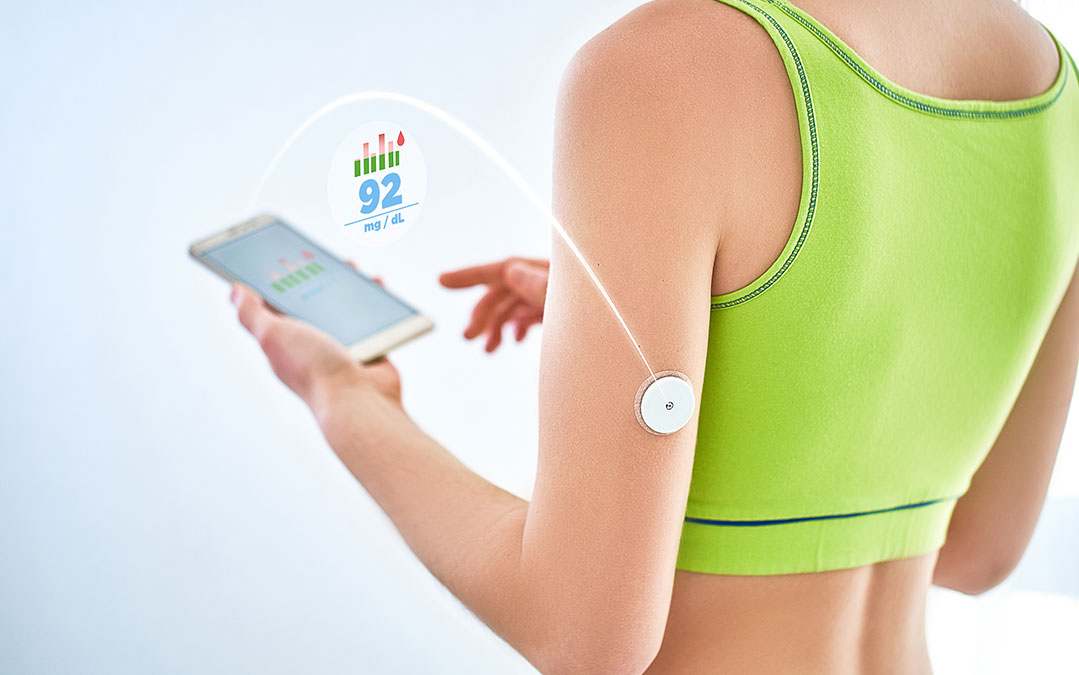If you have diabetes, you are probably a pro at monitoring your own blood sugar. Whether you take periodic finger-stick tests throughout the day or you use the new continuous glucose monitoring technology, you already know how important it is to keep track of what your blood sugar is doing in response to food and insulin. But what if you don’t have diabetes, or what if you are (or suspect you might be) pre-diabetic? Could you benefit from knowing what your blood sugar is doing throughout the day? Absolutely.
Your blood sugar level is an important indicator of how food, as well as less obvious things like exercise, sleep, and stress, influence your health. Knowledge is power, and anyone who wants to take charge of their own health status can benefit from more personalized health information. Food is the one lifestyle factor you have the most control over—you literally get to make health decisions with every bite you put into your mouth. Blood sugar data about you and how food affects you (as opposed to some public health study averaging many people) can help guide your decisions about what to eat and what not to eat, to create health and vibrancy from within.
Blood Glucose Is Energy
As part of the digestion and metabolism processes, your body breaks down the food you eat and extracts the carbohydrates and proteins, breaking them down further into glucose, which goes into your bloodstream. The presence of sugar in your blood triggers your pancreas to release insulin, which accompanies glucose into the cells so your body can use it for energy. Although we can also use fat for fuel through a different process that creates ketones, glucose is the body’s preferred and most easily utilized form of fuel. Your brain alone uses over half the glucose you produce from food and needs a steady supply—around 420 calories a day, just to keep your brain on task.
This process should work seamlessly, but if you eat too much food and too much glucose comes pouring into your bloodstream, your insulin has to double down to get that blood sugar safely stowed in cells. If your insulin runs out of useful storage spots (like the muscles cells and the liver), it still has to get that glucose out of your blood, where it can do damage to your organs if it hangs around for too long. The next best spot is in fat cells, so your body will fill up your fat cells with glucose, and make more fat cells, if necessary.
If this glucose flooding keeps up, eventually your pancreas can become so over-worked that it loses its ability to produce enough insulin. Your cells can also become insulin resistant—it’s like they see that insulin coming with more glucose on board and they hang a “closed” sign on the door because they’ve had enough. That’s when glucose may keep circulating in your blood, and that’s when your blood sugar gets—and stays—too high. And that, my friends, is diabetes, along with all its destructive potential complications, from heart disease to blindness, painful neuropathy, wounds that won’t heal, and worse.
Glucose Monitoring for Better Decisions
When you test your blood sugar before and after eating, this information can reveal when your blood sugar is going too high, or staying too high, so you know what foods, and what amount of food, has that effect. A healthy blood sugar response should be a gentle rolling hill of ups and downs, not a terrifying roller-coaster glucose spike of sky-highs and deep drops. While you can get a general picture through finger-stick testing, the advantage a continuous glucose monitor is that it gives you points of data every few minutes, all day and all night, laid out for you in a graph.
This is important information. Although in general, high-carb foods, especially containing sugar and simple starches, spike blood sugar the highest, we now know that every person has individual responses to the same foods. You might get a spike from a banana, but not from a piece of toast. Someone else might get a spike from rice, but not from pasta, or from a bowl of breakfast cereal, but not from oatmeal and blueberries. You cannot know unless you test.
When you know what your blood sugar is likely to do, you can make better decisions, protect your organs, reduce body fat, and guard against developing diabetes in the future. Considering that in the United States, 1 in 10 people have diagnosed diabetes and 1 in 3 adults have pre-diabetes, that’s not such an unlikely disease scenario.
Continuous Glucose Monitoring: Barriers and Systems to Watch
Right now, in the United States, continuous glucose monitors are officially produced for people with diabetes. They are not marketed for those who do not have a diabetes diagnosis, nor are they available without a prescription (you don’t need a prescription for them in Europe). This is typical of conventional medicine—the tools are only available to those with advanced diagnoses and not available in the service of prevention.
However, that doesn’t mean you can’t get one. If you can convince your doctor that you are worried about your risk of diabetes, especially if you have a family history of diabetes, or if you are significantly overweight or have other risk factors, you may be able to get that coveted prescription. If you are pre-diabetic, your doctor is even more likely to agree. If your doctor is forward-thinking, you may be able to get one even without an obvious reason. Just be aware that your insurance may not pay for it.
The two companies most known for their CGMs are Abbott, which makes the Freestyle Libre, and Dexcom, which makes the G6, but several other companies are currently developing CGMs that may soon be available to anyone without a prescription. The pot of gold we all desire is a non-invasive continuous glucose monitor. The current CGMs have a small wire inside a disk that sticks to the back of your arm. You don’t really feel the wire, but it does penetrate the skin, and that is a deal breaker for many. A promising avenue for this is incorporating glucose monitoring into wearable tech. Chances are, your smartwatch will soon be able to do the job.
I look forward to the day that everyone can see, in real time, what their blood sugar is doing in response to their dietary choices, as well as their stress levels, sleep quality, and exercise (blood sugar often goes higher during times of high stress, and stays more stable after a good night’s sleep, or the day after a good workout). When we all have access to this data, those who choose can prevent type 2 diabetes from ever happening to them, since it is entirely preventable through lifestyle. Keep an eye on the health news for developments, but in the meantime, if you really want to know what your blood sugar is doing, consider asking your doctor about how you could get a CGM, even if you only wear it for a couple of weeks. That’s enough to get information that can guide your dietary decisions even when you are no longer wearing one.


